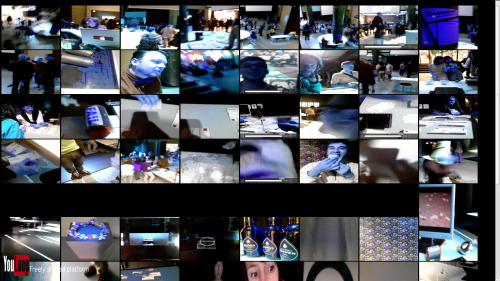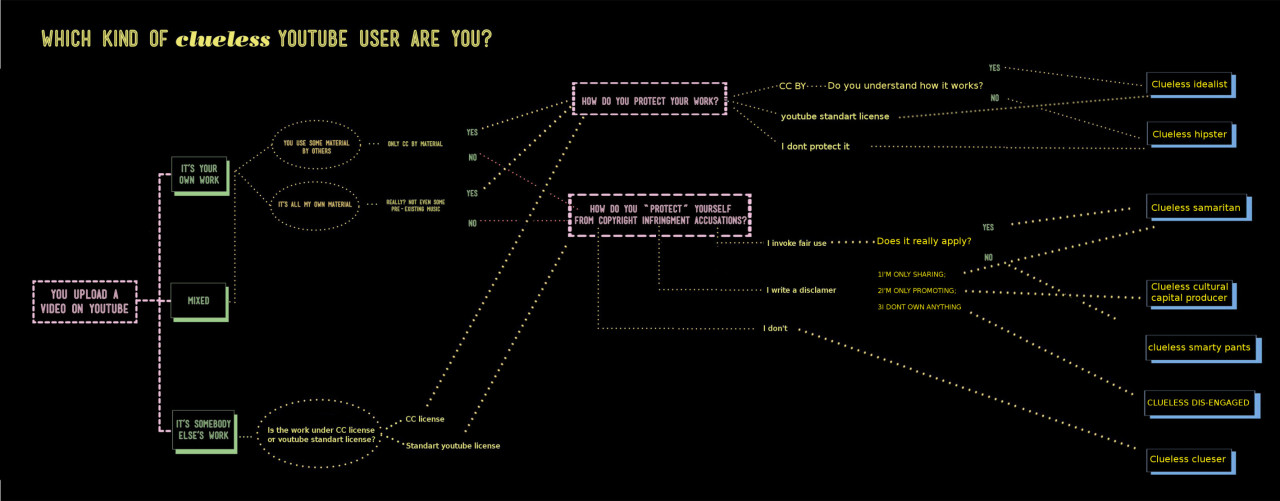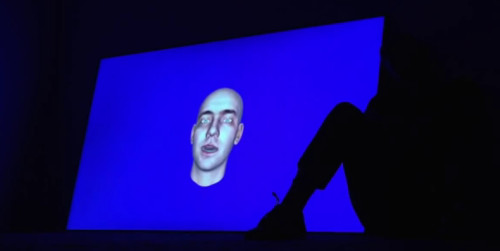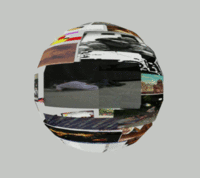User:Mihail Bakalov/Trimester 4/GraduateResearchSeminar/ProjectProposal
How our on-line profile is comprised from external elements and more specifically how others influence and construct our identity in social media networks such as Facebook? How does added and linked content from user's friends side, create person's on-line profile?
This project would consist of creating a platform mimicking Facebook. It would be similar to a Facebook analysis application where you get certain emphasis on a type of content. Focusing on the data such as posts, tags, likes and comments linked from the social circle of a user to him. Copying that information to the new platform and constructing a profile from this secondhand data. Taking data from Facebook and putting it in a similar interface like a page with a vertical scroll were the information is tiled up, one above the other. This platform would also consist of a digital avatar, a mesh object having implemented inside visually all the data from a person's profile as the texture of this 3D shaped avatar. This mesh consists of all the secondhand data displayed as its skin, which circulates around the sides of the object. The structure of the shape would depend on the amounts of specidic type of content, each part of the mesh corresponding to a different type of data. If a person wants to create a profile on the new platform all he has to do is become friends on Facebook with the installation's profile. In that way the on-line application software of the installation would have access to your data and would copy it to the new platform. The copied information would consist of tagged and posted content, likes and comments from the social circle of the person's.
A possible installation in the exhibition would consist of a a dual projection on the walls of the space and a touch screen controller, for example a tablet. One projection would display the digital avatar, the other will visualize the data that is being added to the person's profile, displaying the new platform interface of the person's wall showing the last five added items. The tablet would be for interacting with the avatar. A participant would be able to transform, pull and stretch the shape . This transformation of the shape would generate data in the place of alteration. It would send posts, links, pictures with tags and comments from the profile of the installation to the person's profile. The avatar would be fed with data and will grow bigger. This data would be sent to the person's profile on the new platform.
When entering the exhibition space, a viewer would be presented with the dual screen projection and a tablet. The touch screen surface of the tablet is provided as a controller for allowing a participant to interact with the digital visualization. One can either start interacting with the current profile or choose another one. Both projections would be updated in real-time when interaction is present. I am doing this project to explore how our on-line identity is comprised out of external elements. By presenting the isolated data which is showing the influence of others upon a person and focusing on how easy is the modification a person's profile done over his friends.
--Here are some other shape examples of digital avatars
In the past 8 months I took a look into on-line social networks, how users create content on them, which components of these platforms are mostly used and tried to experimenting in this field. How the user creates an on-line personality, transformed from the design of the social platform and established modes of behavior.
Currently my research is on exploring the influence of other people upon the self and how they contribute into our on-line profile(as building identity). How people in your social circle in on-line environment are able to add content and link materials to your profile, with which expanding it, altering and restructuring it. Focusing on the aspect of the internet personalities as comprised of external elements.
Exploring and interpreting the proverb “Who you surround yourself with, the same you become” in online social platforms. Overall usage statistics of Facebook show that it's more common for users to post content on other people's profiles in the spirit of sharing information and socializing, rather than posting on their own wall. Part of the statistic show normally people have one out of four post on their wall made by them and the others added from their social circle. That makes this social platform more organized on the reflection of others and the contribution of external elements.
Example of influence from a user's social circle: a time-line representation of facebook activities of a person
Within my previous research I was looking at selfies as part of people's on-line profile as a portrait of the user on social networks. More particularly how they take an active part in peoples on-line selves, what influence is applied to them and how do they present us. Looking at these self-portraits as a reflection of the self, where the user is motivated to create them as it helps keeping the coherence and stability of the social I. The users identity formed and altered by on-line social networks creating an extension of the self. This extension is separated from the real self, presenting an amplification of the real individual and separating from him, forming it's own new look, situated on-line presenting it self and available to anyone who wants to see it.
As a part of my selfie research I started working on an experiment called “Get rid of your self”
- Get rid of your self
Exploring the alteration of the profile by self-performative actions taken from the user on his profile. The script tries to find a replacement of you which is similar to you taking a look at coincidence of posted links, similarities between number of friends, content uploaded and amount of usual daily activity. As a final outcome this project presents you with a list of people, possible surrogates which have the most similarities to your profile.
- Youloop (V2_ exhibition)
In the project from the third trimester I took an exploration in social networks and user generated content. I gaining experience in creating an on-line platform for sharing content. Building a local social network consisting of a video platform for users. It was used to share videos recorded in the exhibition space and it consisted a dual screen projection of the collected footage. Involving a commercial element for exploring the motivation of participants. In this experiment participants recorded videos with their smart phones and upload to the local video platform where they were presented with two options in which they lose their copyrights over the footage. The first is to donate it for free to an open public station providing download to anyone for free. The second is a platform where people receive monetary reward for their images.
http://headroom.pzwart.wdka.hro.nl/~mbakalov/rotator_bckup.php

- Every link you click
In this project "Every link you click", a script collecting visual elements form every link clicked browsing through the internet. It creates a visual profile filled with images from the browsing history of a person. Exploring the person from the actions he took on the web.
- YouTube User
Researching the field of copyrights and their application in the internet environment and the cases of copyright infringement. This is a participatory project exploring specifically Youtube as an environment and peoples behavior. Participants draw their own way through the labyrinth as they answer the questions on the path. The outcome is a statistic linked to the categorization formed on the basis of the of with intellectual property.
In collaboration with Lidia Pereira, Caetano Carvalho, Max Dovey & Solange Frankort.

I will go on investigating personal identity, I would like to look at how does the process of creating and managing an identity takes place on-line. Looking at Lacan's researches about reflection of identity in another persons eyes and making experiments around how is that constituted on-line. How the on-line identity can be found in Lacan's mirror stage, as a reflection keeping the stability of our social life.
Going through Jean Paul Sartre's writing about how we are conscious of one's self through the affects that others have on the us. Exploring what kind of an extension of our selfs is the 3rd party contributed network identity?
RELATED ARTISTS
- Ed Atkins – No one is more "work" then me - https://www.youtube.com/watch?v=8XXzW6XcXyQ
This project is related to showing the online identity of a person but focusing on the self-performance side. Ed Atkins makes work in the process of life’s mediation through contemporary digital technologies: where and how bodies and beings are represented, to themselves and to others, and in what way our experiences are more or less verifiable, fed back to an embodied and immanent self. Using CGI, HD video, and audio he explores these possibilities by explicitly generating life-like imagery and effects to underscore the mortal and irrecoverable aspects of experience, resisting the material deferral innate to digital technique.

- R. Lyon – The Limits of Perception and the Rectangular Frame #6
This project takes a look at the data that a online dating service provides about people and uses it for another purpose than the original. A re-imagining of the self-portrait in the age of algorithmically conditioned social media. Using a loophole on the dating site OkCupid, Lyon asks the site to show him other heterosexual males that are the most like him— his digital doppelgangers according to the site’s data analysis. Running this protocol locally in Utrecht, Lyon has invited several high-percentage matches to the opening of the exhibition to serve as a kind of constellated, proprietary self-portrait.
- loveMachine
The love machine focuses on the influence of the flow of data, the links between user actions and reflections on the algorithms functioning on social networks. It explores the hidden relations between socializing and content of advertisements from an extreme point.
The upcoming Thesis proposal would be practise based, coinciding with the theme of the project proposal. Also it would be exploring the fields of online identity on social media networks and the influence of the design of the platform in terms of socializing between users. I will continue with readings on Jacques Lacan and Jean Paul Sartre which are connected to the social relationships a person builds. About the design of social networks I will focus on writes such as Sherry Turkle, Geert Lovink and Evgeny Morozov.
Throughout small prototypes and practical assignments I will:
- Going through facebook profile data, looking for third party content and scraping the needed information.
The images that I have uploaded to my profile.
http://headroom.pzwart.wdka.hro.nl/~mbakalov/identity/jpegsge.php
Images linked and tagged by other people to me.
http://headroom.pzwart.wdka.hro.nl/~mbakalov/identity/jpegs.php
- Creating a 3D mesh avatar with it.
- Prototyping an interaction with the created 3D shape.
How our online profile is comprised from external elements and more specifically how others influence and construct our identity in social media networks such as Facebook? How does added and linked content from user's friends side, create his/her online character?
An interactive installation consisting of a dual screen projection. The installation focuses on the content of a user's profile on a social network such as facebook and more specifically on the content that has being contributed to him by others in his social circle. One projection will display the 3rd party content of the profile which will be molded into a visualization of an abstract three dimensional human head. The size and shape will be based upon the amount of content that has being uploaded and linked to the profile by other people. In other sense the head will be a graph consistent of certain elements that are part of the user's account. The interactive part will be transforming this avatar, like modeling a sculpture. Physically remodeling the shape of it with your hands, done by sensor detection connected t o the projection of the digital avatar. A participant in the space would be able to alter, stretch and deform the shape of the visualization. In this project the digital avatar is used as a controller, a visual output which is used as a “joystick” to enable the participant to remodel the profile. The second beamer will show what affect this interaction has on the user's profile in the social network. It will depict the flow of data generated from the interaction, such as posting links and messages on the user's wall and uploading and tagging images with him. Showing the effect of others upon the one's on-line social network identity.
The past 8 months I took a look into on-line social networks, how users create content on them, which componets of these platforms are mostly used and tried to experimenting in this field. In my last research I was looking at selfies inhabiting online social networks and presenting a reflection of the identity of the user. How the user creates an on-line personality, transformed from the design of the social platform and established modes of behaviour. Now I want to take a look at the influence of other people upon the self and how they contribute into our on-line profile(as building identity). How people in your social circle in online environment are able to add content and link materials to your profile, with which expanding it, altering and restructuring it. Focusing on the aspect of the internet personalities as comprised of external elements. I want to explore how the information from my social circles, builds a part of my identity, but also creates a reference for 3rd partys. Interpretating the proverb “Who you surround yourself with, the same you become” in online social platforms and the refraction of the identity of the person from anothers eyes, into a third persons view. In Lacanian terms how the signifier represents the signifier for another signifier in the on-line social space.
EXAMPLE OF INFLUENCE FROM A USER'S SOCIAL CIRCLE:
The images that I have uploaded to my profile. http://headroom.pzwart.wdka.hro.nl/~mbakalov/identity/jpegsge.php
Images linked and tagged by other people to me. http://headroom.pzwart.wdka.hro.nl/~mbakalov/identity/jpegs.php
Within my last research I was looking at selfies as part of people's on-line profile as a portrait of the user on social networks. More particularly how they take an active part in peoples on-line selves, what influence is applied to them and how do they present us. Looking at these self-portraits as a reflection of the self, where the user is motivated to create them as it helps keeping the coherence and stability of the social I. The users identity formed and altered by on-line social networks creating an extension of the self. This extension is separated from the real self, presenting an amplification of the real individual and separating from him, forming it's own new look, situated on-line presenting it self and available to anyone who wants to see it.
As a part of my selfie research I started working on an experiment called “Get rid of your self”
- Get rid of your self
Exploring the alteration of the profile by self-performative actions taken from the user on his profile. The script tries to find a replacement of you which is similar to you taking a look at coincidence of posted links, similarities between number of friends, content uploaded and amount of usual daily activity. As a final outcome this project presents you with a list of people, possible surrogates which have the most similarities to your profile.
- Youloop (V2_ exhibition)
In the project from the third trimester I took an exploration in social networks and user generated content. Building a local social network consisting of a video platform for users to share videos recorded in the exhibition space and a dual screen projection of the collected footage. Involving a commercial element for exploring the motivation of participants. In this experiment participants recorded videos with their smart phones and upload to the local video platform where they were presented with two options in which they lose their copyrights over the footage. The first is to donate it for free to an open public station providing download to anyone for free. The second is a platform where people receive monetary reward for their images.
http://headroom.pzwart.wdka.hro.nl/~mbakalov/rotator_bckup.php

- Every link you click
In this project "Every link you click", a script collecting visual elements form every link clicked browsing through the internet. It creates a visual profile filled with images from the browsing history of a person. Exploring the person from the actions he took on the web.
- YouTube User
Researching the field of copyrights and their application in the internet environment and the cases of copyright infringement. This is a participatory project exploring specifically Youtube as an environment and peoples behavior. Participants draw their own way through the labyrinth as they answer the questions on the path. The outcome is a statistic linked to the categorisation formed on the basis of the of with intellectual property.
In collaboration with Lidia Pereira, Caetano Carvalho, Max Dovey & Solange Frankort.

I will go on investigating personal identity, I would like to look at how does the process of creating and managing an identity takes place on-line. Looking at Lacan's researches about reflection of identity in another persons eyes and making experiments around how is that constituted on-line. How the online identity can be found in Lacan's mirror stage, as a reflection keeping the stability of our social life.
Going through Jean Paul Satre's writing about how we are conscious of one's self through the affects that others have on the us. Exploring what kind of an extension of our selfs is the 3rd party contributed network identity?
Related artists
- Ed Atkins – No one is more "work" then me - https://www.youtube.com/watch?v=8XXzW6XcXyQ
Ed Atkins makes work in the process of life’s mediation through contemporary digital technologies: where and how bodies and beings are represented, to themselves and to others, and in what way our experiences are more or less verifiable, fed back to an embodied and immanent self. Using CGI, HD video, and audio he explores these possibilities by explicitly generating life-like imagery and effects to underscore the mortal and irrecoverable aspects of experience, resisting the material deferral innate to digital technique.

- R. Lyon – The Limits of Perception and the Rectangular Frame #6
A re-imagining of the self-portrait in the age of algorithmically conditioned social media. Using a loophole on the dating site OkCupid, Lyon asks the site to show him other heterosexual males that are the most like him— his digital doppelgangers according to the site’s data analysis. Running this protocol locally in Utrecht, Lyon has invited several high-percentage matches to the opening of the exhibition to serve as a kind of constellated, proprietary self-portrait.
Throughout small prototypes and practical assignments I will:
- Going through facebook profile data, looking for third party content and scraping the needed information.
The images that I have uploaded to my profile.
http://headroom.pzwart.wdka.hro.nl/~mbakalov/identity/jpegsge.php
Images linked and tagged by other people to me.
http://headroom.pzwart.wdka.hro.nl/~mbakalov/identity/jpegs.php
- Creating a 3D mesh avatar with it.
- Prototyping an interaction with the created 3D shape.
Jean Paul Sartre - "No Exit"
Tiziana Terranova - Attention, economy and the brain
Eric Schmidt - The New Digital Age
Sherry Turkle - Alone together
Jane Hedley-Prole - What about me?
Geert Lovink - Networks without a cause
Evgeny Morozov - The netdelusion
Olga Goriunova - Databaseness
Sarah S. Jain - Prostheticpathology
Jacques Lacan - The mirror stage as formative of the function of the I as revealed in psychoanalytic experience



